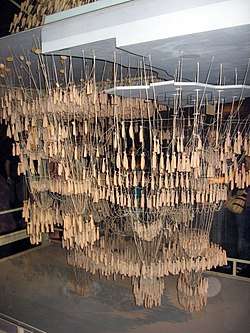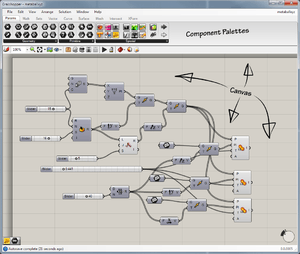Parametric design
Parametric design is a process based on algorithmic thinking that enables the expression of parameters and rules that, together, define, encode and clarify the relationship between design intent and design response.[1][2]
Parametric design is a paradigm in design where the relationship between elements is used to manipulate and inform the design of complex geometries and structures.
The term parametric originates from mathematics (parametric equation) and refers to the use of certain parameters or variables that can be edited to manipulate or alter the end result of an equation or system. While today the term is used in reference to computational design systems, there are precedents for these modern systems in the works of architects such as Antoni Gaudí, who used analog models to explore design space.[3]
Parametric modeling systems can be divided into two main types:
- Propagation-based systems where one computes from known to unknowns with a dataflow model.
- Constraint systems which solve sets of continuous and discrete constraints.[4]
Form-finding is one of the strategies implemented through propagation-based systems. The idea behind form-finding is to optimize certain design goals against a set of design constraints.[4]
History (early examples)
Analogue parametric design

One of the earliest examples of parametric design was the upside down model of churches by Antonio Gaudi. In his design for the Church of Colònia Güell he created a model of strings weighted down with birdshot to create complex vaulted ceilings and arches. By adjusting the position of the weights or the length of the strings he could alter the shape of each arch and also see how this change influenced the arches connected to it. He placed a mirror on the bottom of the model to see how it should look upside-down.
Features of Gaudi's method
Gaudi's analogue method includes the main features of a computational of a parametric model (input parameters, equation, output):
- The string length, birdshot weight and anchor point location all form independent input parameters
- The vertex locations of the points on the strings being the outcomes of the model
- The outcomes are derived by explicit functions, in this case gravity or Newtons law of motion.
By modifying individual parameters of these models Gaudi could generate different versions of his model while being certain the resulting structure would stand in pure compression. Instead of having to manually calculate the results of parametric equations he could automatically derive the shape of the catenary curves through the force of gravity acting on the strings.[5]
Sketchpad
Where Gaudi used physical laws to speed up his calculation of parametric equations, Ivan Sutherland looked to the processing power of digital computers.
Sutherland created an interactive computer-aided design program called Sketchpad. Using a light pen, users could draw lines and arcs that could be related to each other using constraints. These constraints contained all the essential properties of parametric equations. Users could experiment and explore different designs by altering the parameters of an entity and let Sketchpad do the calculations and redraw the geometry according to the constraints imposed upon it.[5]
Architecture

Nature has always served as inspiration for architects and designers. Computer technology has given designers and architects the tools to analyse and simulate the complexity observed in nature and apply it to structural building shapes and urban organizational patterns. In the 1980s architects and designers started using computers running software developed for the aerospace and moving picture industries to "animate form".[6]
One of the first architects and theorists that used computers to generate architecture was Greg Lynn. His blob and fold architecture is some of the early examples of computer generated architecture. Shenzhen Bao'an International Airport's new Terminal 3, finished in 2013, designed by Italian architect Massimiliano Fuksas, with parametric design support by the engineering firm Knippers Helbig, is an example for the use of parametric design and production technologies in a large scale building.
Urban design
Parametric urbanism is concerned with the study and prediction of settlement patterns. Architect Frei Otto distinguishes occupying and connecting as the two fundamental processes that are involved with all urbanisation.[7] Studies look at producing solutions that reduce overall path length in systems while maintaining low average detour factor or facade differentiation.
Software
[Power Surfacing]
Power Surfacing is a SOLIDWORKS application for industrial design / freeform organic surface / solids modeling. Tightly integrated with SOLIDWORKS, it works with all SOLIDWORKS commands. Reverse Engineer scanned meshes with Power Surfacing RE.
Catia
CATIA (Computer Aided three-dimensional Interactive Application) was used by architect Frank Gehry to design some of his award-winning curvilinear buildings such as the Guggenheim Museum Bilbao.[8] Gehry Technologies, the technology arm of his firm, have since created Digital Project, their own parametric design software based on their experience with CATIA.
Autodesk 3DS Max
Autodesk 3ds Max is a parametric 3D modeling software which provides modeling, animation, simulation, and rendering functions for games, film, and motion graphics. 3ds Max uses the concept of modifiers and wired parameters to control its geometry and gives the user the ability to script its functionality. Max Creation Graph is a visual programming node-based tool creation environment in 3ds Max 2016 that is similar to Grasshopper and Dynamo.
Autodesk Maya
Autodesk Maya is a 3D computer graphics software originally developed by Alias Systems Corporation (formerly Alias|Wavefront) and currently owned and developed by Autodesk, Inc. It is used to create interactive 3D applications, including video games, animated film, TV series, or visual effects. Maya exposes a node graph architecture. Scene elements are node-based, each node having its own attributes and customization. As a result, the visual representation of a scene is based on a network of interconnecting nodes, depending on each other's information. Maya is equipped with a cross-platform scripting language, called Maya Embedded Language. MEL is provided for scripting and a means to customize the core functionality of the software, since many of the tools and commands used are written in it. MEL or Python can be used to engineer modifications, plug-ins or be injected into runtime. User interaction is recorded in MEL, allowing novice users to implement subroutines.
Grasshopper 3D

Grasshopper 3d (originally Explicit History) is a plug-in for Rhinoceros 3D that presents the users with a visual programming language interface to create and edit geometry.[9]
Components or nodes are dragged onto a canvas in order to build a grasshopper definition. Grasshopper is based on graphs (see Graph (discrete mathematics)) that map the flow of relations from parameters through user-defined functions (nodes), resulting in the generation of geometry. Changing parameters or geometry causes the changes to propagate throughout all functions, and the geometry to be redrawn.[5]
Autodesk Revit
Autodesk Revit is building information modeling (BIM) software used by architects and other building professionals. Revit was developed in response to the need for software that could create three-dimensional parametric models that include both geometry and non-geometric design and construction information. Every change made to an element in Revit is automatically propagated through the model to keep all components, views and annotations consistent. This eases collaboration between teams and ensures that all information (floor areas, schedules, etc.) are updated dynamically when changes in the model are made.
Autodesk Dynamo
Dynamo is an open source graphical programming environment for design. Dynamo extends building information modeling with the data and logic environment of a graphical algorithm editor.
GenerativeComponents
GenerativeComponents, parametric CAD software developed by Bentley Systems,[10] was first introduced in 2003, became increasingly used in practice (especially by the London architectural community) by early 2005, and was commercially released in November 2007. GenerativeComponents has a strong traditional base of users in academia and at technologically advanced design firms. GenerativeComponents is often referred to by the nickname of 'GC'. GC epitomizes the quest to bring parametric modeling capabilities of 3D solid modeling into architectural design, seeking to provide greater fluidity and fluency than mechanical 3D solid modeling.
Users can interact with the software by either dynamically modeling and directly manipulating geometry, or by applying rules and capturing relationships among model elements, or by defining complex forms and systems through concisely expressed algorithms. The software supports many industry standard file input and outputs including DGN by Bentley Systems, DWG by Autodesk, STL (Stereo Lithography), Rhino, and others. The software can also integrate with Building Information Modeling systems.
The software has a published API and uses a simple scripting language, both allowing the integration with many different software tools, and the creation of custom programs by users.
This software is primarily used by architects and engineers in the design of buildings, but has also been used to model natural and biological structures and mathematical systems.
Generative Components runs exclusively on Microsoft Windows operating systems.
Marionette
Marionette is an open source graphical scripting tool (or visual programming environment) for the architecture, engineering, construction, landscape, and entertainment design industries that is built into the Mac and Windows versions of Vectorworks software. The tool was first made available in the Vectorworks 2016 line of software products. Marionette enables designers to create custom application algorithms that build interactive parametric objects and streamline complex workflows, as well as build automated 2D drawing, 3D modeling, and BIM workflows within Vectorworks software.
Built in the Python programming language, everything in Marionette consists of nodes which are linked together in a flowchart arrangement. Each node contains a Python script with predefined inputs and outputs that can be accessed and modified with a built-in editor. Nodes are placed directly into the Vectorworks document and then connected to create complex algorithms. Since Marionette is fully integrated into Vectorworks software, it can also be used to create entirely self-contained parametric objects that can be inserted into new and existing designs.
Modelur
Modelur is a parametric urban design software plug-in for Trimble SketchUp, developed by Agilicity d.o.o. (LLC).. Its primary goal is to help the users create conceptual urban massing. In contrast to common CAD applications, where the user designs buildings with usual dimensions such as width, depth and height, Modelur offers design of built environment through key urban parameters such as number of storeys and gross floor area of a building.
Modelur calculates key urban control parameters on the fly (e.g. floor area ratio or required number of parking lots), delivering urban design information while the development is still evolving. This way it helps taking well-informed decision during the earliest stages, when design decisions have the highest impact.
Archimatix
Archimatix is a node-based parametric modeler extension for Unity 3D. It enables visual modeling of 3D models within the Unity 3D editor.
See also
References
- Jabi, Wassim (2013). Parametric Design for Architecture. London: Laurence King. ISBN 9781780673141.
- Woodbury, Robert (2010). Elements of Parametric Design. Routledge. ISBN 978-0415779876.
- Frazer, John (2016). "Parametric Computation: History and Future". Architectural Design. 86 (March/April): 18–23. doi:10.1002/ad.2019.
- Woodbury, Robert; Williamson, Shane; Beesley, Philip (2006). "Parametric Modeling as a Design Representation in Architecture: a process account". Cumulative Index of Computer Aided Architectural Design.
- Davis, Daniel. "A History of Parametric". Retrieved 5 April 2014.
- "Parametric Design: a Brief History". AIACC. Retrieved 5 April 2014.
- Schumacher, Patrik (2009). "Parametricism - A New Global Style for Architecture and Urban Design". AD Architectural Design. 79 (4).
- "The construction - Guggenheim Museum Bilbao". Guggenheim Museum Bilbao. Retrieved 2017-05-20.
- "Grasshopper". Retrieved 25 February 2016.
- "Computational Design Software". Retrieved 25 February 2016.